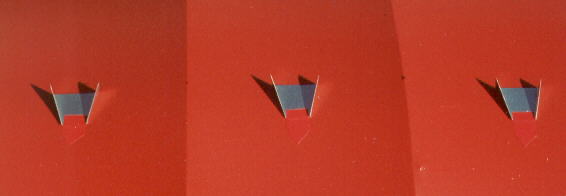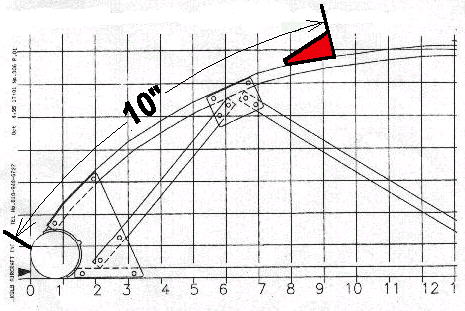|
|
|
 |
Vortex generators swirl the air as it passes over the wing of a slow flying aircraft and in doing so reduces the boundary layer thickness of the air on the trailing side of the wing. The effect is to delay turbulent air separation from the wing which increases wing load carrying capability or lift and reduces stall speed. Boundary layer thickness reduction improves aileron effectiveness too because the aileron has less distance to deflect before it moves out of slow dead air thickness that is attached to the trailing wing surface. In the previous picture of concept vortex generators, I had placed a vortex generator on every full and false rib and in between each rib. They were attached with a strip of black electrician's tape. I started out with one on each full rib, and then by slowly advancing the throttle, I flew the plane off into ground effect. Then I added one to each middle false rib, all false ribs, and then between all ribs. There was some effect on the ribs, but when I put them in between the ribs, I found a very noticeable change. When I made the real (good) ones, I placed them in between the ribs first. The effect was just as effective as with them on and in between the ribs. I believe this is due to the air spilling sideways off the rib into the valleys between the ribs, where the vortex generator spins it back out. These vortex generators were mounted using 3/4 inch wide Scotch Double-Coated Tape. The bottom of the generators is cleaned with lacquer thinner before attaching the tape. After the fabric is cleaned the vortex generator is mounted to the wing in between the ribs and ll to 12 inches back from the leading edge. The electrical color coding tape is used to prevent the possibility of the leading edge of the generator from lifting in flight. I put these on to increase low speed lift so that I could get off soft wet grass fields. After mounting the plane flew off into ground effect at 27 mph indicated which was four mph less than before. Rate of climb was improved by 200 fpm. Before I could not maintain a constant 50 mph indicated climb at full throttle. At 50 mph indicated it would climb well then taper off and push or mush and then climb again. With the generators, it climbs at a constant rate at 50 and 45 mph indicated, and at 40 mph indicated it climbs, mushes and climbs again. Slow speed flight at 4500 rpm, one can slowly pull the stick back and the plane will climb. By continuing to move the stick back the climb rate meter will fall to zero. At this point the indicated airspeed is less than 20 mph. Before it was 28 mph. At this point one can deflect the ailerons and it will spin on the prop without dropping a wing. The FireFly has a short wing so it is a little twitchy in roll, but with the vortex generators it acts like it has a larger higher aspect ratio wing. It is much more solid feeling, especially when turning from down wind to base. With a fairly good wind, I would never make a steep bank, but with the vortex generators there is no feeling that the wing is going to lift and force you into a steeper bank. Aileron effectiveness is increased. As soon as you open the throttle the ailerons are effective. No problems with taking off and landing in cross winds. I have been asked why I mounted the vortex generators so far back on the wing when others place them more forward on the airfoil. I believe they could be moved forward on the airfoil and they would probably work just as well. I put them as far back as I felt they would receive good air flow with the FireFly in the three wheel stance and to increase low speed lift. For a given speed, I assumed that the vortex energy will dissipate as the vortex moves back over the wing surface, and as it does the boundary layer thickness will once again begin to increase. By placing the vortex generators further back, vortex energy should remain higher toward the wing trailing edge. This should help to reduce the boundary layer thickness over the ailerons and improve aileron effectiveness at low speed. |
|
Vortex Generator Position On The Wing
 |